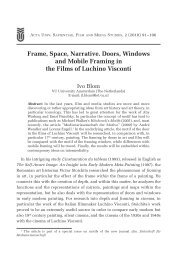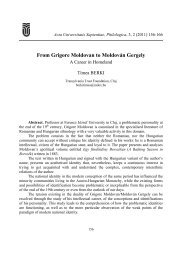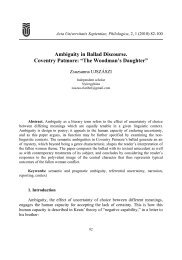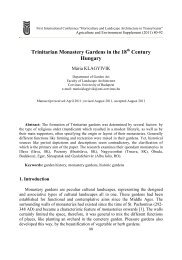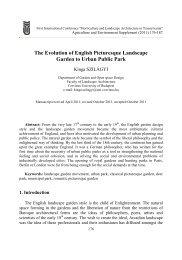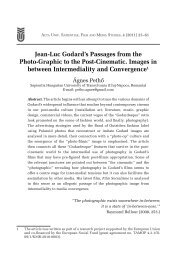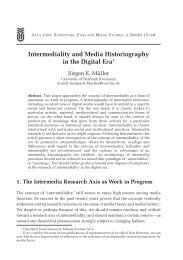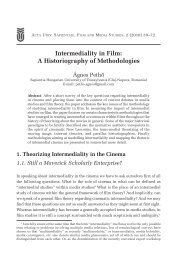On Some Pecularities of Paloid Bevel Gear Worm-Hobs - Acta ...
On Some Pecularities of Paloid Bevel Gear Worm-Hobs - Acta ...
On Some Pecularities of Paloid Bevel Gear Worm-Hobs - Acta ...
Create successful ePaper yourself
Turn your PDF publications into a flip-book with our unique Google optimized e-Paper software.
<strong>Acta</strong> Universitatis Sapientiae<br />
Electrical and Mechanical Engineering, 2 (2010) 159-165<br />
<strong>On</strong> <strong>Some</strong> <strong>Pecularities</strong> <strong>of</strong> <strong>Paloid</strong> <strong>Bevel</strong> <strong>Gear</strong><br />
<strong>Worm</strong>-<strong>Hobs</strong><br />
Dénes HOLLANDA, Márton MÁTÉ<br />
Department <strong>of</strong> Mechanical Engineering, Faculty <strong>of</strong> Technical and Human Sciences,<br />
Sapientia University, Tg. Mureş,<br />
e-mail: hollanda@ms.sapientia.ro, mmate@ms.sapientia.ro<br />
Manuscript received November 11, 2010; revised November 24, 2010.<br />
Abstract: The paper discusses the generating surfaces <strong>of</strong> the paloid bevel worm hob<br />
used for paloid gear cutting. A pitch modification is required by this type <strong>of</strong> tool in<br />
order to ensure the optimal contact pattern by gearing. As a consequence <strong>of</strong> this<br />
modification the flank line <strong>of</strong> the plain gear tooth results as a paloid- a more general<br />
shaped curve than the theoretical involute <strong>of</strong> the basic circle. Equations <strong>of</strong> the<br />
generating surfaces result as equations <strong>of</strong> a generalized arhimedic bevel helical surface<br />
presenting those modifications that arise from the variation <strong>of</strong> the tooth thickness.<br />
The first subsection discusses the essential geometrical peculiarities <strong>of</strong> the paloid<br />
worm hob. Here it is to remark that the most important characteristic <strong>of</strong> the tool is the<br />
variation <strong>of</strong> the tooth thickness on the rolling tape generator. The tooth thickness has its<br />
minimum value at the middle <strong>of</strong> the generator, and is maximum on the extremities. As a<br />
consequence, the generated gear tooth presents an opposite variation <strong>of</strong> thickness. The<br />
thickness variation is realized by moving the relieving tool on an ellipse, but this is not<br />
the only possible trajectory to be used.<br />
The second subsection presents the generalized mathematical model <strong>of</strong> the tooth<br />
thickness variation. Starting from the ellipse used by classical relieving technologies,<br />
and writing the equation <strong>of</strong> the ellipse reported to the coordinate system <strong>of</strong> the paloid<br />
hob it results the radius function <strong>of</strong> the revolved surface <strong>of</strong> the reference helix. This<br />
function is used in its condensed form. With this, the developed mathematical model<br />
can be used for other forms <strong>of</strong> the relieving tool trajectory.<br />
The next paragraphs present the matrix transformations between the coordinate<br />
systems <strong>of</strong> the hob and the relieving tool. Finally the parametric equations <strong>of</strong> the hob<br />
tooth flank are obtained. These equations depend on the radius modification function.<br />
Using other relieving trajectories that differ from an ellipse, other tooth flank forms will<br />
be obtained. Using this model, the flanks <strong>of</strong> the cut gear tooth can be easily written for<br />
all types <strong>of</strong> trajectories.
160 D. Hollanda, M. Máté<br />
Keywords: paloid bevel worm hob, tooth thickness modification, generating<br />
surface.<br />
1. General description<br />
<strong>Paloid</strong> bevel gears are realized on Klingelnberg type teething machine-tools,<br />
using paloid bevel gear worm-hobs [1], [6]. These tools present a straightshaped<br />
edge in their axial section. As a conclusion, the origin surface <strong>of</strong> the<br />
paloid worm hob is an Arhimedic bevel worm having the half taper angle <strong>of</strong> 30°<br />
as shown in Fig. 1. [4], [5]. The chip-collecting slots are axially driven. In order<br />
to realize the clearance angle on all edges, a helical relieving, perpendicularly<br />
oriented to the bevel generator is allowed.<br />
Figure 1: The paloid worm hob characteristic dimensions.<br />
In order to ensure the good positioning <strong>of</strong> the contact patch by paloid gears,<br />
the pitch <strong>of</strong> the tool is variable but the tooth thickness (measured on the rolling<br />
taper generator) must increase at the extremities <strong>of</strong> the tool. Using this principle,<br />
the tooth thickness on the rolling tape generator increases in both directions<br />
starting from the point N (Fig. 2).
<strong>On</strong> <strong>Some</strong> <strong>Pecularities</strong> <strong>of</strong> <strong>Paloid</strong> <strong>Bevel</strong> <strong>Gear</strong> <strong>Worm</strong>-<strong>Hobs</strong> 161<br />
Figure 2: The tooth thickness distribution along the cone generator.<br />
The thickness <strong>of</strong> teeth in case <strong>of</strong> gears manufactured using the worm-hob<br />
described above results smaller at the tooth extremities and larger in the middle<br />
<strong>of</strong> it. This localizes the contact pattern in the middle <strong>of</strong> the tooth-flank when<br />
gearing. This modification causes the deformation <strong>of</strong> the tooth line on the plain<br />
gear too, transforming the theoretical involute into a more general shaped curve<br />
named paloid.<br />
Both the threading and the relieving operation are realized on a relieving<br />
machine, where the axis <strong>of</strong> the worm-hob is declined with a 30° angle reported<br />
to the axis <strong>of</strong> the chuck, in a horizontal plain containing the axis. This way the<br />
taper generator becomes parallel with the direction <strong>of</strong> the longitudinal slider.<br />
The curved generator <strong>of</strong> the worm-hob is realized through leading the cutter<br />
slider by a pr<strong>of</strong>iled turning-template. The same template is used by the<br />
threading and relieving operations.<br />
<strong>Bevel</strong> worm hobs present one thread, and allow the cutting <strong>of</strong> any teeth<br />
number by a fixed module and pressure angle. The pitch is normalized along the<br />
rolling cone generator and can be calculated using the formula: pN = π ⋅ mN<br />
.<br />
The axial pitch (defined on the worm hob’s axis) is determined by<br />
<br />
pA = π ⋅ mN<br />
⋅ cos30<br />
.
162 D. Hollanda, M. Máté<br />
2. The geometry <strong>of</strong> the tooth thickness modification<br />
Considering the bevel worm-hob as a helical bevel surface, like any bevel<br />
thread, it is to mention that next to the axial pitch, a radial pitch can be defined,<br />
depending on the axial pitch and the half taper angle <strong>of</strong> the rolling cone (30 o ). If<br />
the generator <strong>of</strong> the worm hob were a straight line, the radial pitch value would<br />
o<br />
satisfy the expression h = pA<br />
⋅ tg30<br />
. However, the generator is curved and the<br />
radial pitch is calculated taking into account the fact that the endpoint <strong>of</strong> the<br />
characteristic radius must be on that generator. Considering the tool’s pressure<br />
angle α , the distance between the curved and the straight generators (based on<br />
the dimensions <strong>of</strong> the tool pr<strong>of</strong>ile indicated in [1], [2], [6]) can be calculated<br />
using the formula<br />
∆1 = ( p N + 0,<br />
01⋅<br />
mN<br />
− pN<br />
) / 2 ⋅ tgα<br />
= 0,<br />
01⋅<br />
mN<br />
/ 2 ⋅ tgα<br />
applicable for point A (Fig 3). The same distance is indicated related to point C<br />
(Fig 3). In point D, the distance discussed above will increase to double as<br />
follows from the formula ∆ 2 = ( p N + 0,<br />
02 ⋅ mN<br />
− pN<br />
) / 2 ⋅ tgα<br />
= 2∆1<br />
.<br />
The curved generator is usually an arc <strong>of</strong> ellipse <strong>of</strong> which major axis<br />
(superposed to the Ox) is parallel to the rolling cone generator, and it’s minor<br />
axis (superposed to Oy) passes through point B (Fig 3), situated at a distance <strong>of</strong><br />
F + 2 p from the top <strong>of</strong> the rolling cone.<br />
eo<br />
N<br />
Figure 3: The elliptically curved generator.
<strong>On</strong> <strong>Some</strong> <strong>Pecularities</strong> <strong>of</strong> <strong>Paloid</strong> <strong>Bevel</strong> <strong>Gear</strong> <strong>Worm</strong>-<strong>Hobs</strong> 163<br />
It is to remark that the ellipse passes through the following points:<br />
A( − pN<br />
, a − ∆ 1)<br />
; B ( 0,<br />
a)<br />
; C( − 2.<br />
pN<br />
, ∆ 1)<br />
and D( −4. pN<br />
, a − ∆ 2)<br />
.<br />
The canonic equation <strong>of</strong> an arbitrarily shaped ellipse, reported to its axes, is:<br />
x<br />
a<br />
2<br />
2<br />
y<br />
+<br />
b<br />
2<br />
2<br />
−1<br />
= 0<br />
Writing the equation <strong>of</strong> the ellipses passing through the points A, B, C and D<br />
a system <strong>of</strong> equation will result, <strong>of</strong> which solution leads to the reference radius<br />
o<br />
endpoint function e.g. h = f ( pN<br />
/ cos30<br />
) . In this paper the radial pitch is<br />
accepted having a general form as expressed by the above formula. As a<br />
consequence, the relations deduced in the following can be used for other forms<br />
<strong>of</strong> the curved generator too. Using this form, the essential aspects <strong>of</strong> the<br />
dependences will not be influenced by the very sophisticated expressions <strong>of</strong> the<br />
radial pitch [3].<br />
The matrix equation <strong>of</strong> the bevel worm hob’s edge, reported to the self<br />
coordinate system, is:<br />
⎛ π ⋅ mN<br />
⎞<br />
⎜ Feo<br />
− ⎟[cos30°<br />
+ tg30°<br />
sin( 30°<br />
− α)]<br />
+ λ sin( 30°<br />
− α)]<br />
⎝ 4 ⎠<br />
r =<br />
λ cosα<br />
M<br />
(2)<br />
0<br />
1<br />
This edge is fixed to the mobile coordinate system O M X MYM<br />
Z M<br />
superposed at the initial moment with the fixed coordinate system OXYZ . The<br />
parametric form <strong>of</strong> the edge expressed in the mobile system will is denoted by<br />
rM but it keeps the form <strong>of</strong> rt given by (2).<br />
The surface <strong>of</strong> the generator flank <strong>of</strong> the bevel worm hob can be obtained<br />
considering the followings: the edge is fixed to the mobile coordinate system<br />
(Fig 4) that executes a helical motion reported to the stationary system. The<br />
origin moves in the direction <strong>of</strong> axis with an amount <strong>of</strong> p A ⋅ϕ<br />
, simultaneously<br />
with a rotation by angle ϕ <strong>of</strong> the worm-hob (representing the workpiece in the<br />
above case).<br />
(1)
164 D. Hollanda, M. Máté<br />
Figure 4: The position <strong>of</strong> the right edge related to the used reference system.<br />
First the edge must be reported to an auxiliary coordinate system. Between<br />
this and the auxiliary system OM X MYM<br />
Z M there exist only translations by<br />
amounts <strong>of</strong> p A ⋅ϕ<br />
/ 2π<br />
and h ⋅ϕ<br />
/ 2π<br />
respectively. A transfer matrix describing<br />
the above translations is:<br />
M<br />
aM<br />
pA<br />
1 0 0 ϕ<br />
2π<br />
h<br />
= 0 1 0 ϕ<br />
(3)<br />
2π<br />
0 0 1 0<br />
0<br />
0<br />
After that the edge’s equation is transformed to the stationary system,<br />
mentioning that auxiliary system executes only a rotation around its X axis,<br />
characterized by the matrix<br />
1<br />
0<br />
0<br />
0<br />
0<br />
1<br />
0<br />
0 cosϕ<br />
− sinϕ<br />
0<br />
M Oa =<br />
(4)<br />
0 sinϕ<br />
cosϕ<br />
0<br />
0<br />
0<br />
1
<strong>On</strong> <strong>Some</strong> <strong>Pecularities</strong> <strong>of</strong> <strong>Paloid</strong> <strong>Bevel</strong> <strong>Gear</strong> <strong>Worm</strong>-<strong>Hobs</strong> 165<br />
The pointing vector <strong>of</strong> the bevel helical surface described by the edge,<br />
reported to the stationary reference system is obtained from the following<br />
matrix equation<br />
r = M Oa ⋅ M aM . ⋅ rM<br />
Multiplying M Oa by M aM it results<br />
= M OM ⋅ rM<br />
(5)<br />
MOM<br />
=<br />
1<br />
0<br />
0<br />
0<br />
0<br />
cosϕ<br />
sinϕ<br />
0<br />
0<br />
− sinϕ<br />
cosϕ<br />
0<br />
pA<br />
ϕ<br />
2π<br />
h<br />
ϕ.<br />
cosϕ<br />
2π<br />
h<br />
ϕ.<br />
sinϕ<br />
2π<br />
1<br />
(6)<br />
Finally, the matrix expression <strong>of</strong> the pointing vector is:<br />
X<br />
Y<br />
Z<br />
1<br />
pA<br />
1 0 0 ϕ<br />
2π<br />
X M<br />
h<br />
0 cosϕ<br />
− sinϕ<br />
ϕ.<br />
cosϕ<br />
YM<br />
= 2π<br />
.<br />
(7)<br />
h<br />
ZM<br />
0 sinϕ<br />
cosϕ<br />
ϕ.<br />
sinϕ<br />
2π<br />
1<br />
0 0 0 1<br />
Expression (7) realizes the matrix form <strong>of</strong> the right flank <strong>of</strong> the bevel wormhob<br />
tooth, reported to the stationary system OXYZ, attached to the hob.<br />
Analytical expression is obtained after multiplying the matrices in the<br />
equation before. Similarly results the equations <strong>of</strong> the opposite flank, if starting<br />
the calculus with the equations <strong>of</strong> the opposite edge.<br />
References<br />
[1] Krumme, W., “Klingelnberg-Spiralkegelräder Dritte neubearbeitete Auflage”, Springer<br />
Verlag, Berlin, 1967.<br />
[2] *** “MASINOSTROIENIE”- ENCYCLOPEDY, Vol.VII., Masghiz Moskou.<br />
[3] Máté, M., Hollanda, D. “The Enveloping Surfaces <strong>of</strong> the <strong>Paloid</strong> Mill Cutter”, in Proc. 18 th<br />
International Conference on Mechanical Engineering, Baia Mare, 23-25 April 2010, pp.<br />
291-294.<br />
[4] Michalski, J., Skoczylas, L. “Modeling the tooth flanks <strong>of</strong> hobbed gears in the CAD<br />
environment", The International Journal <strong>of</strong> Advanced Manufacturing Technology, vol. 36,<br />
no. 7-8, 2008.<br />
[5] Shu-han Chen, Hong –zhi Jan, Xing-zu Ming, “Analysis and modeling <strong>of</strong> error <strong>of</strong> spiral<br />
bevel gear grinder based on multi-body system theory", Journal <strong>of</strong> Central South<br />
University <strong>of</strong> Technology, vol. 15, no. 5, 2008.<br />
[6] Klingelnberg, J. “Kegelräder- Grundlagen, Anwendungen”, Springer Verlag, 2008.



